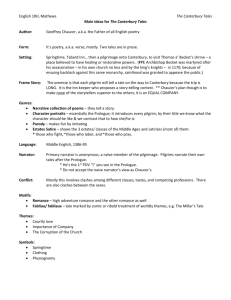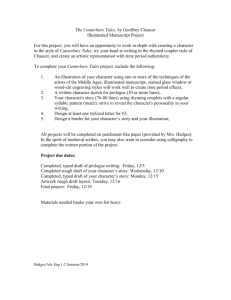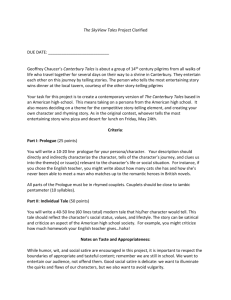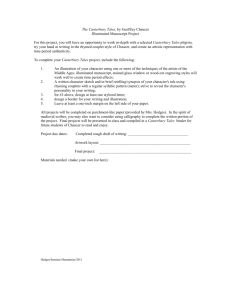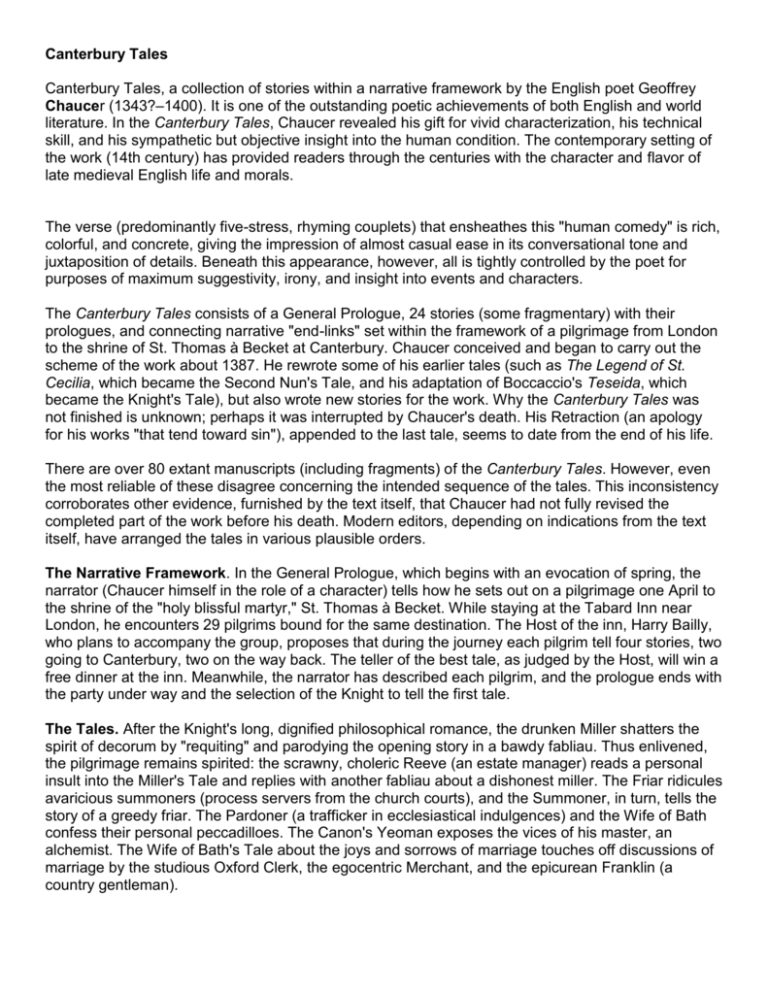
Canterbury Tales
Canterbury Tales, a collection of stories within a narrative framework by the English poet Geoffrey
Chaucer (1343?–1400). It is one of the outstanding poetic achievements of both English and world
literature. In the Canterbury Tales, Chaucer revealed his gift for vivid characterization, his technical
skill, and his sympathetic but objective insight into the human condition. The contemporary setting of
the work (14th century) has provided readers through the centuries with the character and flavor of
late medieval English life and morals.
The verse (predominantly five-stress, rhyming couplets) that ensheathes this "human comedy" is rich,
colorful, and concrete, giving the impression of almost casual ease in its conversational tone and
juxtaposition of details. Beneath this appearance, however, all is tightly controlled by the poet for
purposes of maximum suggestivity, irony, and insight into events and characters.
The Canterbury Tales consists of a General Prologue, 24 stories (some fragmentary) with their
prologues, and connecting narrative "end-links" set within the framework of a pilgrimage from London
to the shrine of St. Thomas à Becket at Canterbury. Chaucer conceived and began to carry out the
scheme of the work about 1387. He rewrote some of his earlier tales (such as The Legend of St.
Cecilia, which became the Second Nun's Tale, and his adaptation of Boccaccio's Teseida, which
became the Knight's Tale), but also wrote new stories for the work. Why the Canterbury Tales was
not finished is unknown; perhaps it was interrupted by Chaucer's death. His Retraction (an apology
for his works "that tend toward sin"), appended to the last tale, seems to date from the end of his life.
There are over 80 extant manuscripts (including fragments) of the Canterbury Tales. However, even
the most reliable of these disagree concerning the intended sequence of the tales. This inconsistency
corroborates other evidence, furnished by the text itself, that Chaucer had not fully revised the
completed part of the work before his death. Modern editors, depending on indications from the text
itself, have arranged the tales in various plausible orders.
The Narrative Framework. In the General Prologue, which begins with an evocation of spring, the
narrator (Chaucer himself in the role of a character) tells how he sets out on a pilgrimage one April to
the shrine of the "holy blissful martyr," St. Thomas à Becket. While staying at the Tabard Inn near
London, he encounters 29 pilgrims bound for the same destination. The Host of the inn, Harry Bailly,
who plans to accompany the group, proposes that during the journey each pilgrim tell four stories, two
going to Canterbury, two on the way back. The teller of the best tale, as judged by the Host, will win a
free dinner at the inn. Meanwhile, the narrator has described each pilgrim, and the prologue ends with
the party under way and the selection of the Knight to tell the first tale.
The Tales. After the Knight's long, dignified philosophical romance, the drunken Miller shatters the
spirit of decorum by "requiting" and parodying the opening story in a bawdy fabliau. Thus enlivened,
the pilgrimage remains spirited: the scrawny, choleric Reeve (an estate manager) reads a personal
insult into the Miller's Tale and replies with another fabliau about a dishonest miller. The Friar ridicules
avaricious summoners (process servers from the church courts), and the Summoner, in turn, tells the
story of a greedy friar. The Pardoner (a trafficker in ecclesiastical indulgences) and the Wife of Bath
confess their personal peccadilloes. The Canon's Yeoman exposes the vices of his master, an
alchemist. The Wife of Bath's Tale about the joys and sorrows of marriage touches off discussions of
marriage by the studious Oxford Clerk, the egocentric Merchant, and the epicurean Franklin (a
country gentleman).
The overly refined and mundane Prioress sentimentalizes the story, then popular, of a pious little
Christian boy who is murdered by Jews and avenged through the miraculous intervention of the
Virgin. The Monk, who prefers hunting and a fine roast to monastic rigor, nonetheless recounts a
dignified and learned collection of medieval tragedies. The Squire, brilliantly depicted in the General
Prologue as the embodiment of high-spirited youth, tells a fantastic romance (one of the incomplete
tales) into which Chaucer introduced themes from his early poetry. The Nun's Priest tells a beast epic,
about a pompous cock and a vain and foolish fox, in which bombastic rhetoric and humankind's
pretensions to understand and control life are ridiculed.
After the worldliness and bawdiness of many of the tales, Chaucer planned a pious ending. One of
the completed tales, delivered by the simple, idealized Parson, is a sermon on the seven deadly sins.
This selection, intended as the last of the projected 120 stories, is the final offering in modern
versions of the Canterbury Tales.
Chaucer's Aim. Chaucer's objective in the Canterbury Tales was to present the fascinating
relationship between art and reality. His tales, which encompass a great variety of genres and are
told by a highly diversified group of people, offer a wide range of contemporary views of society—
views that are conditioned by the social status and personal temperament of each pilgrim. The
characters of the pilgrims come alive both in their portraits in the General Prologue and in the
revealing encounters between them during the journey. The fact that each pilgrim is simultaneously
an artist (in his tale) and an object of art (in the portrayal of his character) permits an interplay
between the concepts of art and reality that is potentially unlimited in its possibilities for irony and
exposure. Often, a tale generally in harmony with its teller can harbor a moment that is "out of
character." The brutal and amoral Miller, for example, presents a brutal, amoral, and lively view of the
relations between the sexes; yet his pathetic carpenter arouses a sympathy through his devotion to
his lecherous wife that the Miller probably never intended to evoke. In the Merchant's Tale (about a
repulsive marriage), the teller's intent to show how women dupe men in marriage is undermined by
the unappetizing quality of both husband and wife.
Chaucer's concern with the interplay between art and experience is perhaps best seen in his
presentation of the Wife of Bath and the Pardoner. The Wife justifies her constant squabbles with the
five husbands she has dominated by expounding her theory that female sovereignty (maistrie) is the
secret of conjugal felicity. She supports this proposition with evidence from her own life and with a
tale in which a knight who has raped a woman (an extreme act of male sovereignty) is saved from
punishment by an old hag who insists that he marry her. On their wedding night, the mortified groom
resigns sovereignty to her and is rewarded by her metamorphosis into a young, beautiful, and faithful
wife.
In defending this vision of the happy marriage, the Wife betrays herself by her enthusiastic revelations
of how she tormented her husbands; by her quotes from the antifeminist literature (popular at the
time) that she opposes but corroborates by her behavior; and by her admission that her character
partakes of both Venus and Mars, making her a lover of both sex and combat in marriage. Seen in
this light, her tale is a pathetic daydream of rejuvenation at the hands of a sixth husband.
On the other hand, the Pardoner, in his prologue, revels in confessing the corrupt practices by which
he intimidates simple folk. He defrauds them of their earnings with his bogus relics and terrifying
pulpit rhetoric while preaching that such cupidity is the root of all evil. The morality tale he tells
describes how three young men set out to destroy death and, finding a hoard of gold, destroy each
other instead, each one seeking the treasure for himself. The inner irony of the tale matches the irony
of the Pardoner in telling it. The Pardoner's words confirm the description of him in the General
Prologue as a repulsive man but a magnificent performer. Realizing the negative impression he has
made on the other pilgrims, the Pardoner decides to satisfy and surpass their most lurid imaginings.
These two confessional figures, the Wife and the Pardoner, are among the liveliest and most
interesting of the pilgrims. The Wife, as artist, loses control of her considerable art, which works to
undermine and destroy her avowed opinions; the Pardoner, as artist, so controls his art, however
perverse, that he can intentionally and credibly destroy himself in public.
Between these two extremes are such characters as the Knight, whose avowed search for simplicity
in narration is refuted in the elaborate descriptions of his tale, and whose insistence that providence
rules the world for the best is challenged by the long and arbitrary sufferings of his protagonists; the
Franklin, whose optimistic, middle-class exaltation of innate nobility ("gentilesse") jars with his
disappointment at his worthless son, and whose "simple" tale of the triumph of faithful love
elaborately compares art and nature, illusion and reality; and the narrator, whose wretched, popular
romance of Sir Thopas, halted by the disgusted Host, is actually a hilarious satire on a decadent
literary form, unbeknownst to Host or narrator.
Sources. The narrative forms and techniques of the Canterbury Tales are as varied as its sources, or
as the characters who recount and inhabit the tales. Sources and analogues, ranging from French
and Flemish fabliaux to works of Petrarch and Boccaccio, are known for most of the stories in the
Canterbury Tales. Chaucer freely combined and reworked these sources. The inspiration for the
narrative framework may have been Boccaccio's Decameron or the Novelle of another Florentine,
Giovanni Sercambi, or it may have been the more inflexible frame of Chaucer's earlier work, The
Legend of Good Women.
Criticism. Critics are generally agreed that Chaucer occasionally attempted to utilize sources too
intractable even for his adapting genius. The tale told by the Clerk of Oxford perhaps falls into this
category. The Clerk, who is presented as the ideal of devotion to truth and study in the General
Prologue, has learned from Petrarch the story of the sufferings of a patient and faithful wife, Griselda,
whose husband constantly tests her virtue. The Clerk's references to Job and his indignation at the
husband's excesses do not make Griselda seem any more believable. However, Chaucer turns even
this difficulty to his advantage by adding an "envoy," or comment to the tale, in which the Clerk
ironically advises women never to be like Griselda, but rather to imitate the Wife of Bath instead. Here
the poet, with typical ingenuity, uses his narrative frame to save its contents.
Dryden's exclamation at Chaucer's variety—"Here is God's plenty"—remains the most just evaluation
of the achievement of the Canterbury Tales. The collection of pilgrims and their tales will appeal as
long as there is interest in the way people react to each other, and in the way in which individuals
transform their experience and reveal the depths of their being through the narrative art.
Robert W. Hanning
Columbia University
How to cite this article:
MLA (Modern Language Association) style:
Hanning, Robert W. "Canterbury Tales." Encyclopedia Americana. 2007. Grolier Online. 25 Jan. 2007
<http://ea.grolier.com/cgi-bin/article?assetid=0074700-00>.
Copyright © 2007 Scholastic Library Publishing, Inc. All rights reserved.



